

Compact Muon Solenoid
LHC, CERN
| CMS-EXO-18-012 ; CERN-EP-2019-176 | ||
| Search for low mass vector resonances decaying into quark-antiquark pairs in proton-proton collisions at $\sqrt{s} = $ 13 TeV | ||
| CMS Collaboration | ||
| 9 September 2019 | ||
| Phys. Rev. D 100 (2019) 112007 | ||
| Abstract: A search for low mass narrow vector resonances decaying into quark-antiquark pairs is presented. The analysis is based on data collected in 2017 with the CMS detector at the LHC in proton-proton collisions at a center-of-mass energy of 13 TeV, corresponding to an integrated luminosity of 41.1 fb$^{-1}$. The results of this analysis are combined with those of an earlier analysis based on data collected at the same collision energy in 2016, corresponding to 35.9 fb$^{-1}$. Signal candidates will be recoiling against initial state radiation and are identified as energetic, large-radius jets with two pronged substructure. The invariant jet mass spectrum is probed for a potential narrow peaking signal over a smoothly falling background. No evidence for such resonances is observed within the mass range of 50-450 GeV. Upper limits at the 95% confidence level are set on the coupling of narrow resonances to quarks, as a function of the resonance mass. For masses between 50 and 300 GeV these are the most sensitive limits to date. This analysis extends the earlier search to a mass range of 300-450 GeV, which is probed for the first time with jet substructure techniques. | ||
| Links: e-print arXiv:1909.04114 [hep-ex] (PDF) ; CDS record ; inSPIRE record ; CADI line (restricted) ; | ||
| Figures | |

png pdf |
Figure 1:
High-level trigger efficiency as a function of the soft-drop jet mass ($m_\text {SD}$) for AK8 jets with $ {p_{\mathrm {T}}} > $ 525 GeV (blue squares) and CA15 jets with $ {p_{\mathrm {T}}} > $ 575 GeV (red circles). The trigger selection is $ > $95% efficient for 2017 data for both cone sizes and is applied to AK8 jets with masses between 50 and 275 GeV and CA15 jets with masses between 150 and 450 GeV. For jet masses above 200 GeV, the trigger efficiency for the larger CA15 jet decreases slightly. This is due to events for which a reconstructed jet passing the CA15 jet selection does not satisfy the AK8 jet selection at the trigger level. |
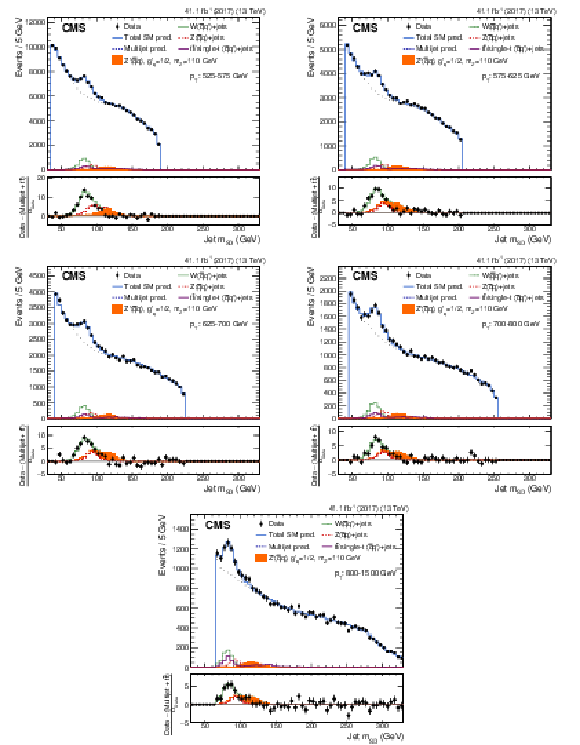
png pdf |
Figure 2:
Jet $m_{\text {SD}}$ distribution in data for AK8 jets for each ${p_{\mathrm {T}}}$ category of the fit. Data are shown by the black points. The multijet background prediction, including uncertainties, is shown by the shaded bands. Contributions from the W and Z bosons, and top quark background processes are shown as well. A hypothetical Z' boson signal with a mass of 110 GeV is also indicated. In the bottom panel, the ratio of the data to its statistical uncertainty, after subtracting the non-resonant backgrounds, is shown. |

png pdf |
Figure 2-a:
Jet $m_{\text {SD}}$ distribution in data for AK8 jets for each ${p_{\mathrm {T}}}$ category of the fit. Data are shown by the black points. The multijet background prediction, including uncertainties, is shown by the shaded bands. Contributions from the W and Z bosons, and top quark background processes are shown as well. A hypothetical Z' boson signal with a mass of 110 GeV is also indicated. In the bottom panel, the ratio of the data to its statistical uncertainty, after subtracting the non-resonant backgrounds, is shown. |
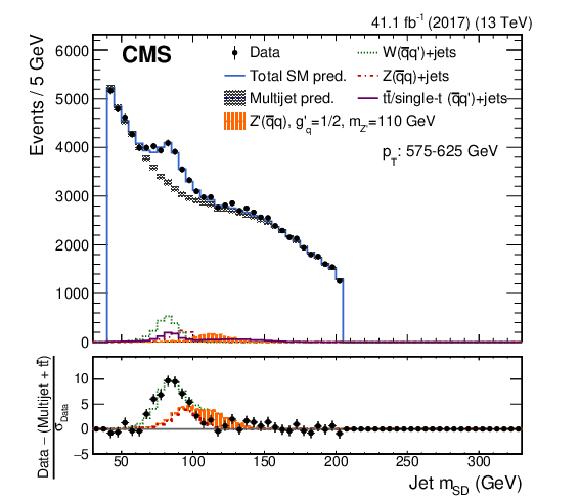
png pdf |
Figure 2-b:
Jet $m_{\text {SD}}$ distribution in data for AK8 jets for each ${p_{\mathrm {T}}}$ category of the fit. Data are shown by the black points. The multijet background prediction, including uncertainties, is shown by the shaded bands. Contributions from the W and Z bosons, and top quark background processes are shown as well. A hypothetical Z' boson signal with a mass of 110 GeV is also indicated. In the bottom panel, the ratio of the data to its statistical uncertainty, after subtracting the non-resonant backgrounds, is shown. |
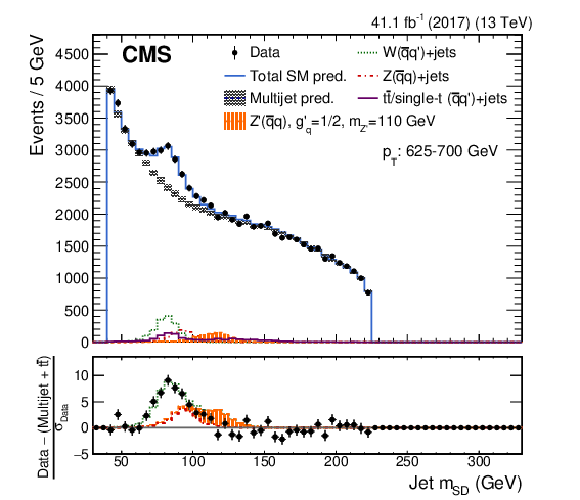
png pdf |
Figure 2-c:
Jet $m_{\text {SD}}$ distribution in data for AK8 jets for each ${p_{\mathrm {T}}}$ category of the fit. Data are shown by the black points. The multijet background prediction, including uncertainties, is shown by the shaded bands. Contributions from the W and Z bosons, and top quark background processes are shown as well. A hypothetical Z' boson signal with a mass of 110 GeV is also indicated. In the bottom panel, the ratio of the data to its statistical uncertainty, after subtracting the non-resonant backgrounds, is shown. |
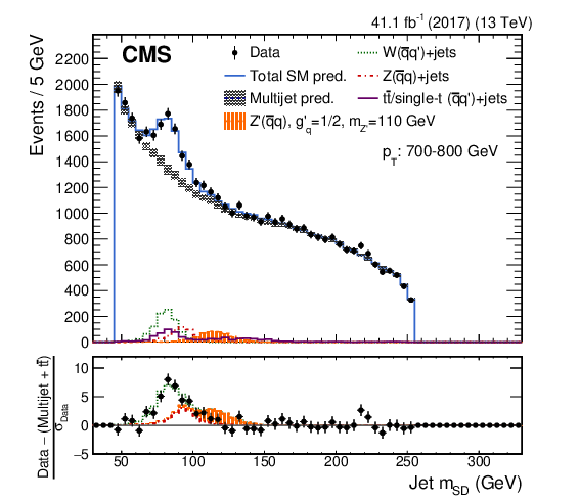
png pdf |
Figure 2-d:
Jet $m_{\text {SD}}$ distribution in data for AK8 jets for each ${p_{\mathrm {T}}}$ category of the fit. Data are shown by the black points. The multijet background prediction, including uncertainties, is shown by the shaded bands. Contributions from the W and Z bosons, and top quark background processes are shown as well. A hypothetical Z' boson signal with a mass of 110 GeV is also indicated. In the bottom panel, the ratio of the data to its statistical uncertainty, after subtracting the non-resonant backgrounds, is shown. |
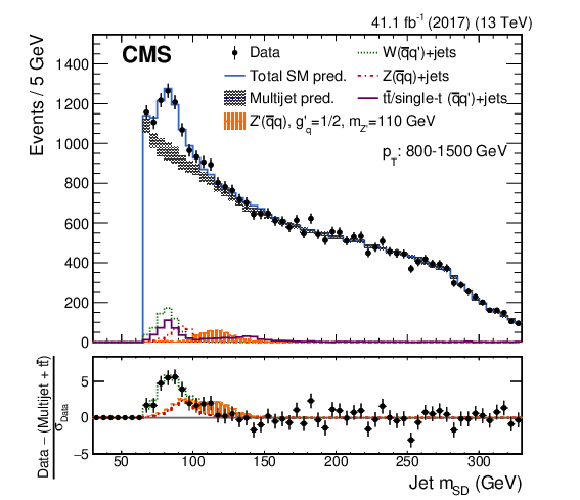
png pdf |
Figure 2-e:
Jet $m_{\text {SD}}$ distribution in data for AK8 jets for each ${p_{\mathrm {T}}}$ category of the fit. Data are shown by the black points. The multijet background prediction, including uncertainties, is shown by the shaded bands. Contributions from the W and Z bosons, and top quark background processes are shown as well. A hypothetical Z' boson signal with a mass of 110 GeV is also indicated. In the bottom panel, the ratio of the data to its statistical uncertainty, after subtracting the non-resonant backgrounds, is shown. |
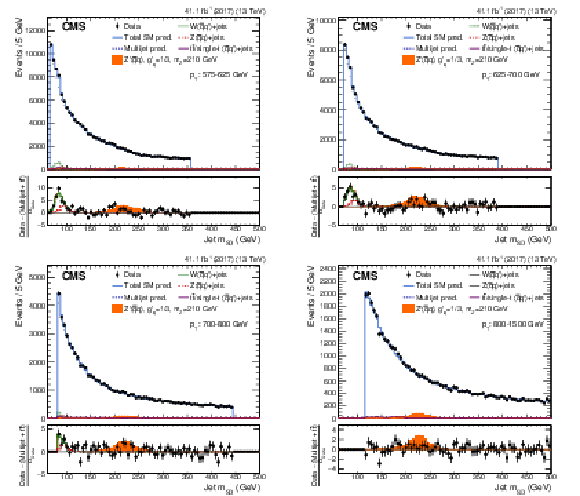
png pdf |
Figure 3:
Jet $m_{\text {SD}}$ distribution in data for CA15 jets for the different ${p_{\mathrm {T}}}$ ranges of the fit from 575 to 1500 GeV. Data are shown as black points. The multijet background prediction, including uncertainties, is shown by the shaded bands. Smaller contributions from the W and Z bosons, and top quark background processes are shown as well. A hypothetical Z' boson signal with a mass of 210 GeV is also indicated. In the bottom panel, the ratio of the data to its statistical uncertainty, after subtracting the non-resonant backgrounds, is shown. |
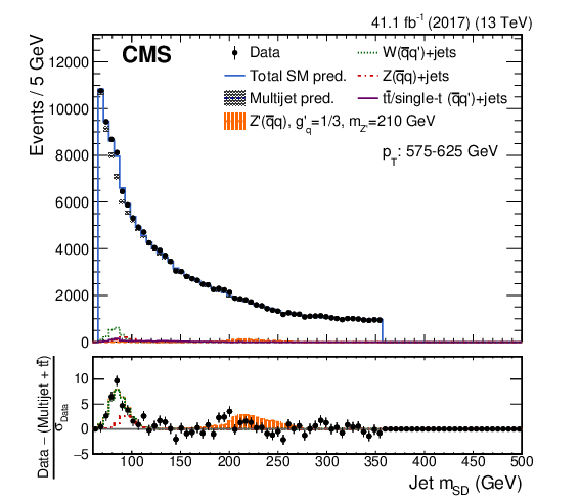
png pdf |
Figure 3-a:
Jet $m_{\text {SD}}$ distribution in data for CA15 jets for ${p_{\mathrm {T}}}$ range of the fit from 575 to 625 GeV. Data are shown as black points. The multijet background prediction, including uncertainties, is shown by the shaded bands. Smaller contributions from the W and Z bosons, and top quark background processes are shown as well. A hypothetical Z' boson signal with a mass of 210 GeV is also indicated. In the bottom panel, the ratio of the data to its statistical uncertainty, after subtracting the non-resonant backgrounds, is shown. |

png pdf |
Figure 3-b:
Jet $m_{\text {SD}}$ distribution in data for CA15 jets for ${p_{\mathrm {T}}}$ range of the fit from 625 to 700 GeV. Data are shown as black points. The multijet background prediction, including uncertainties, is shown by the shaded bands. Smaller contributions from the W and Z bosons, and top quark background processes are shown as well. A hypothetical Z' boson signal with a mass of 210 GeV is also indicated. In the bottom panel, the ratio of the data to its statistical uncertainty, after subtracting the non-resonant backgrounds, is shown. |
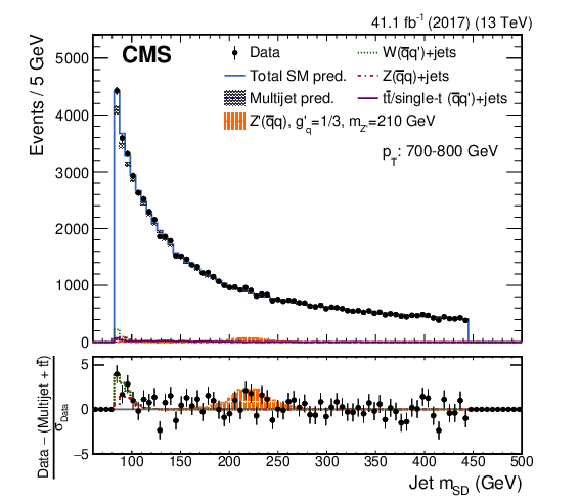
png pdf |
Figure 3-c:
Jet $m_{\text {SD}}$ distribution in data for CA15 jets for ${p_{\mathrm {T}}}$ range of the fit from 700 to 800 GeV. Data are shown as black points. The multijet background prediction, including uncertainties, is shown by the shaded bands. Smaller contributions from the W and Z bosons, and top quark background processes are shown as well. A hypothetical Z' boson signal with a mass of 210 GeV is also indicated. In the bottom panel, the ratio of the data to its statistical uncertainty, after subtracting the non-resonant backgrounds, is shown. |
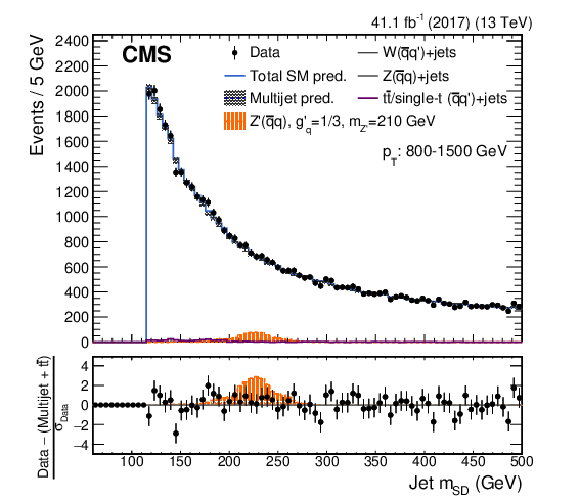
png pdf |
Figure 3-d:
Jet $m_{\text {SD}}$ distribution in data for CA15 jets for ${p_{\mathrm {T}}}$ range of the fit from 800 to 1500 GeV. Data are shown as black points. The multijet background prediction, including uncertainties, is shown by the shaded bands. Smaller contributions from the W and Z bosons, and top quark background processes are shown as well. A hypothetical Z' boson signal with a mass of 210 GeV is also indicated. In the bottom panel, the ratio of the data to its statistical uncertainty, after subtracting the non-resonant backgrounds, is shown. |
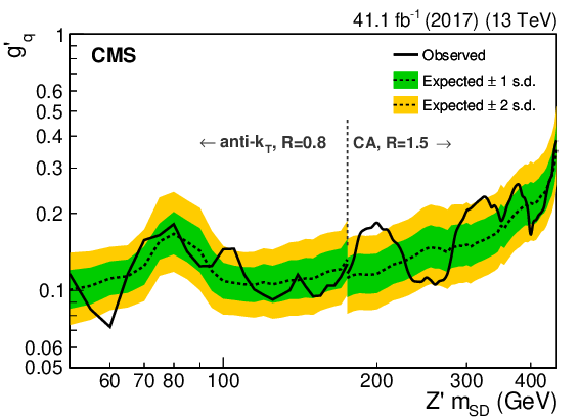
png pdf |
Figure 4:
Upper limits at 95% CL on the coupling $g^{\prime}_{\mathrm {\mathrm{q}}}$ as a function of the resonance mass for a leptophobic Z' boson that couples only to quarks, based on the 2017 analysis. The observed limits (solid), expected limits (dashed), and their variation at the 1 and 2 standard deviation levels (shaded bands) are shown. The vertical line at 175 GeV corresponds to the transition between the AK8 and CA15 jet selections. |

png pdf |
Figure 5:
Upper limits at 95% CL on the coupling $g^{\prime}_{\mathrm {\mathrm{q}}}$ as a function of the resonance mass for a leptophobic Z' boson that couples only to quarks. The observed limits (solid), expected limits (dashed), and their variation at the 1 and 2 standard deviation levels (shaded bands) are shown. For masses between 50 and 220 GeV the limits correspond to a Z' boson reconstructed in AK8 jets using 77.0 fb$^{-1}$ of statistically combined data from 2016 and 2017. For masses above 220 up to 450 GeV, the results correspond to a Z' resonance reconstructed in CA15 jets using 41.1 fb$^{-1}$ of data collected in 2017. |
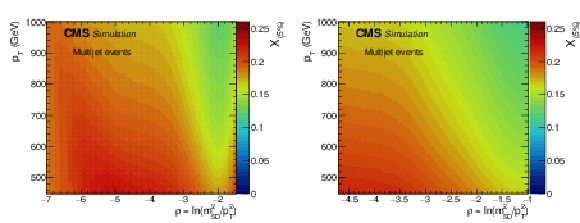
png pdf |
Figure 6:
Distributions of $ X_{(5\%)} $ used to define the $N_2^{1,\text {DDT}}$ variable for AK8 jets (right) and CA15 jets (left), corresponding to the 5% quantile of the $N_2^{1}$ distribution in simulated multijet events. The distributions are shown as a function of the jet $\rho $ and $ {p_{\mathrm {T}}} $. The $N_2^{1}$ variable is mostly insensitive to the jet $\rho $ and $ {p_{\mathrm {T}}} $ in the kinematic phase space considered for this analysis: $-5.5 < \rho < -2.0$ (AK8 jets) and $-4.7 < \rho < -1.0$ (CA15 jets). The distributions of $X_{(5\%)}$ are used to take into account residual correlations in simulation by applying a decorrelation procedure that yields the $N_2^{1,\text {DDT}}$ variable. In order to ensure smoothness of the transformation, we simulate particle-level QCD multijet events and smear them using a parametric detector response derived for the $N_2^{1}$ variable as a function of $\rho $ and $ {p_{\mathrm {T}}} $. This method overcomes the limitation from the limited event count in simulated samples by generating $10^4$ the original number of events available in the multijet simulation. |

png pdf |
Figure 6-a:
Distribution of $ X_{(5\%)} $ used to define the $N_2^{1,\text {DDT}}$ variable for AK8 jets, corresponding to the 5% quantile of the $N_2^{1}$ distribution in simulated multijet events. The distribution is shown as a function of the jet $\rho $ and $ {p_{\mathrm {T}}} $. The $N_2^{1}$ variable is mostly insensitive to the jet $\rho $ and $ {p_{\mathrm {T}}} $ in the kinematic phase space considered for this analysis: $-5.5 < \rho < -2.0$ (AK8 jets) and $-4.7 < \rho < -1.0$ (CA15 jets). The distribution of $X_{(5\%)}$ is used to take into account residual correlations in simulation by applying a decorrelation procedure that yields the $N_2^{1,\text {DDT}}$ variable. In order to ensure smoothness of the transformation, we simulate particle-level QCD multijet events and smear them using a parametric detector response derived for the $N_2^{1}$ variable as a function of $\rho $ and $ {p_{\mathrm {T}}} $. This method overcomes the limitation from the limited event count in simulated samples by generating $10^4$ the original number of events available in the multijet simulation. |

png pdf |
Figure 6-b:
Distribution of $ X_{(5\%)} $ used to define the $N_2^{1,\text {DDT}}$ variable for CA15 jets, corresponding to the 5% quantile of the $N_2^{1}$ distribution in simulated multijet events. The distribution is shown as a function of the jet $\rho $ and $ {p_{\mathrm {T}}} $. The $N_2^{1}$ variable is mostly insensitive to the jet $\rho $ and $ {p_{\mathrm {T}}} $ in the kinematic phase space considered for this analysis: $-5.5 < \rho < -2.0$ (AK8 jets) and $-4.7 < \rho < -1.0$ (CA15 jets). The distribution of $X_{(5\%)}$ is used to take into account residual correlations in simulation by applying a decorrelation procedure that yields the $N_2^{1,\text {DDT}}$ variable. In order to ensure smoothness of the transformation, we simulate particle-level QCD multijet events and smear them using a parametric detector response derived for the $N_2^{1}$ variable as a function of $\rho $ and $ {p_{\mathrm {T}}} $. This method overcomes the limitation from the limited event count in simulated samples by generating $10^4$ the original number of events available in the multijet simulation. |

png pdf |
Figure 7:
Pass-to-fail ratio, $R_{\mathrm {p/f}}(\rho (m_\text {SD}, {p_{\mathrm {T}}}))$, defined from the events passing and failing the $N_2^\text {1,DDT}$ selection. The variable $N_2^\text {1,DDT}$ is constructed so that, for simulated multijet events, $R_{\mathrm {p/f}}$ is constant at $\mathrm {p}=5%$ and $\mathrm {f}=95%$ (blue). To account for residual differences between data and simulation, $R_{\mathrm {p/f}}$ is extracted by performing a two-dimensional fit to data in ($ \rho, {p_{\mathrm {T}}} $) space (orange). The $R_{\mathrm {p/f}}$ shown is derived for AK8 jets using 41.1 fb$^{-1}$ of data collected in 2017 and corresponds to a polynomial in the Bernstein basis of third order in $ {p_{\mathrm {T}}} $ and fifth order in $\rho $. |
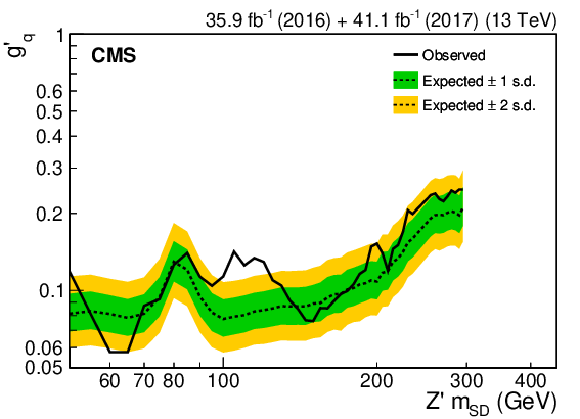
png pdf |
Figure 8:
Upper limits at 95% CL on the coupling $g^{\prime}_{\mathrm {\mathrm{q}}}$ as a function of the resonance mass for a leptophobic Z' boson that couples only to quarks. based on the statistical combination of the 2016 and 2017 analyses using AK8 jets. The observed limits (solid), expected limits (dashed), and their variation at the 1 and 2 standard deviation levels (shaded bands) are shown. |
| Tables | |
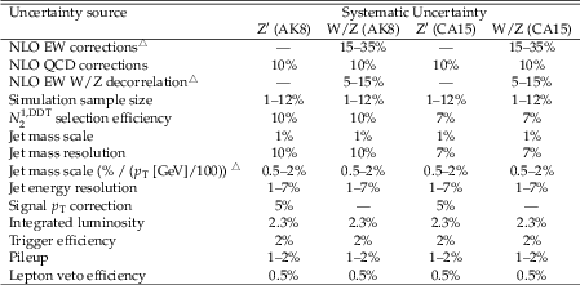
png pdf |
Table 1:
Summary of the systematic uncertainties for signal (Z') and W/Z boson background processes, for AK8 and CA15 jet reconstruction. The reported ranges denote a variation of the uncertainty across $ {p_{\mathrm {T}}} $ bins, from 525 to 1500 GeV (AK8 jets) and from 575 to 1500 GeV (CA15 jets). The symbol $^\triangle $ denotes uncorrelated uncertainties for each $ {p_{\mathrm {T}}} $ bin. For the uncertainties related to the jet mass scale and resolution, the reported percentage reflects a one standard deviation effect on the nominal jet mass shape. A long dash (--) indicates that the uncertainty does not apply. |
| Summary |
| A search for a narrow vector resonance (Z') decaying into a quark-antiquark pair and reconstructed as a single jet with a topology of a resonance recoiling against initial state radiation has been presented. The analysis uses a data set comprised of proton-proton collisions at $\sqrt{s} = $ 13 TeV collected in 2017 at the LHC, corresponding to an integrated luminosity of 41.1 fb$^{-1}$. The results are statistically combined with those obtained with data collected in 2016 to achieve more sensitive exclusion limits with a total integrated luminosity of 77.0 fb$^{-1}$. Jet substructure techniques are employed to identify a jet containing a Z' boson candidate over a smoothly falling jet mass distribution in data. No significant excess above the standard model prediction is observed. Upper limits at 95% confidence level are set on the Z' boson coupling to quarks, $g^{\prime}_{\mathrm{\mathrm{q}}}$, as a function of the Z' boson mass. Coupling values of $g^{\prime}_{\mathrm{\mathrm{q}}} > 0.4$ are excluded over the signal mass range from 50 to 450 GeV, with the most stringent constraints set for masses below 250 GeV where coupling values of $g^{\prime}_{\mathrm{\mathrm{q}}} > $ 0.2 are excluded. For masses between 50 and 300 GeV these are the most sensitive limits to date. The results obtained for masses from 300 to 450 GeV represent the first direct limits to be published in this range for a leptophobic Z' signal reconstructed as a single large-radius jet. |
| References | ||||
| 1 | E. Eichten, I. Hinchliffe, K. D. Lane, and C. Quigg | Super collider physics | Rev. Mod. Phys. 56 (1984) 579 | |
| 2 | U. Baur, I. Hinchliffe, and D. Zeppenfeld | Excited quark production at hadron colliders | Int. J. Mod. Phys. A 2 (1987) 1285 | |
| 3 | P. H. Frampton and S. L. Glashow | Chiral color: An alternative to the standard model | PLB 190 (1987) 157 | |
| 4 | J. L. Hewett and T. G. Rizzo | Low-energy phenomenology of superstring inspired E(6) models | PR 183 (1989) 193 | |
| 5 | U. Baur, M. Spira, and P. M. Zerwas | Excited quark and lepton production at hadron colliders | PRD 42 (1990) 815 | |
| 6 | E. H. Simmons | Coloron phenomenology | PRD 55 (1997) 1678 | hep-ph/9608269 |
| 7 | L. Randall and R. Sundrum | An alternative to compactification | PRL 83 (1999) 4690 | hep-th/9906064 |
| 8 | S. Cullen, M. Perelstein, and M. E. Peskin | TeV strings and collider probes of large extra dimensions | PRD 62 (2000) 055012 | hep-ph/0001166 |
| 9 | L. A. Anchordoqui et al. | Dijet signals for low mass strings at the LHC | PRL 101 (2008) 241803 | 0808.0497 |
| 10 | T. Han, I. Lewis, and Z. Liu | Colored resonant signals at the LHC: Largest rate and simplest topology | JHEP 12 (2010) 085 | 1010.4309 |
| 11 | R. S. Chivukula, A. Farzinnia, E. H. Simmons, and R. Foadi | Production of massive color-octet vector bosons at next-to-leading order | PRD 85 (2012) 054005 | 1111.7261 |
| 12 | D. Abercrombie et al. | Dark matter benchmark models for early LHC Run-2 searches: Report of the ATLAS/CMS Dark Matter Forum | 1507.00966 | |
| 13 | G. Busoni et al. | Recommendations on presenting LHC searches for missing transverse energy signals using simplified $ s $-channel models of dark matter | 1603.04156 | |
| 14 | ATLAS Collaboration | Search for new phenomena in dijet events using 37 fb$^{-1}$ of $ pp $ collision data collected at $ \sqrt{s}= $ 13 TeV with the ATLAS detector | PRD 96 (2017) 052004 | |
| 15 | CMS Collaboration | Search for narrow and broad dijet resonances in proton-proton collisions at $ \sqrt{s}= $ 13 TeV and constraints on dark matter mediators and other new particles | JHEP 08 (2018) 130 | CMS-EXO-16-056 1806.00843 |
| 16 | CMS Collaboration | Search for narrow resonances in dijet final states at $ \sqrt{s} = $ 8 TeV with the novel CMS technique of data scouting | PRL 117 (2016) 031802 | CMS-EXO-14-005 1604.08907 |
| 17 | CMS Collaboration | Search for dijet resonances in proton-proton collisions at $ \sqrt{s} = $ 13 TeV and constraints on dark matter and other models | PLB 769 (2017) 520 | CMS-EXO-16-032 1611.03568 |
| 18 | ATLAS Collaboration | Search for low-mass dijet resonances using trigger-level jets with the ATLAS detector in $ pp $ collisions at $ \sqrt{s}= $ 13 TeV | PRL 121 (2018) 081801 | 1804.03496 |
| 19 | CMS Collaboration | Search for low mass vector resonances decaying to quark-antiquark pairs in proton-proton collisions at $ \sqrt{s} = $ 13 TeV | PRL 119 (2017) 111802 | CMS-EXO-16-030 1705.10532 |
| 20 | CMS Collaboration | Search for low mass vector resonances decaying into quark-antiquark pairs in proton-proton collisions at $ \sqrt{s}= $ 13 TeV | JHEP 01 (2018) 097 | CMS-EXO-17-001 1710.00159 |
| 21 | ATLAS Collaboration | Search for light resonances decaying to boosted quark pairs and produced in association with a photon or a jet in proton-proton collisions at $ \sqrt{s}= $ 13 TeV with the ATLAS detector | PLB 788 (2019) 316 | 1801.08769 |
| 22 | CMS Collaboration | Search for low-mass quark-antiquark resonances produced in association with a photon at $ \sqrt{s} = $ 13 TeV | Submitted to PRLett | CMS-EXO-17-027 1905.10331 |
| 23 | ATLAS Collaboration | Search for low-mass resonances decaying into two jets and produced in association with a photon using $ pp $ collisions at $ \sqrt{s} = $ 13 TeV with the ATLAS detector | PL795 (2019) 56 | 1901.10917 |
| 24 | B. A. Dobrescu and F. Yu | Coupling-mass mapping of dijet peak searches | PRD 88 (2013) 035021 | 1306.2629 |
| 25 | CMS Collaboration | The CMS experiment at the CERN LHC | JINST 3 (2008) S08004 | CMS-00-001 |
| 26 | CMS Collaboration | The CMS trigger system | JINST 12 (2017) 1020 | CMS-TRG-12-001 1609.02366 |
| 27 | GEANT4 Collaboration | GEANT4---a simulation toolkit | NIMA 506 (2003) 250 | |
| 28 | J. Alwall et al. | The automated computation of tree-level and next-to-leading order differential cross sections, and their matching to parton shower simulations | JHEP 07 (2014) 079 | 1405.0301 |
| 29 | J. Alwall et al. | Comparative study of various algorithms for the merging of parton showers and matrix elements in hadronic collisions | EPJC 53 (2008) 473 | 0706.2569 |
| 30 | P. Nason | A new method for combining NLO QCD with shower Monte Carlo algorithms | JHEP 11 (2004) 040 | hep-ph/0409146 |
| 31 | S. Frixione, P. Nason, and C. Oleari | Matching NLO QCD computations with Parton Shower simulations: the POWHEG method | JHEP 11 (2007) 070 | 0709.2092 |
| 32 | S. Alioli, P. Nason, C. Oleari, and E. Re | A general framework for implementing NLO calculations in shower Monte Carlo programs: the POWHEG BOX | JHEP 06 (2010) 043 | 1002.2581 |
| 33 | T. Sjostrand et al. | An introduction to PYTHIA 8.2 | CPC 191 (2015) 159 | 1410.3012 |
| 34 | CMS Collaboration | Extraction and validation of a new set of CMS PYTHIA8 tunes from underlying-event measurements | Submitted to PRD | CMS-GEN-17-001 1903.12179 |
| 35 | NNPDF Collaboration | Parton distributions from high-precision collider data | EPJC 77 (2017) 663 | 1706.00428 |
| 36 | CMS Collaboration | Search for dark matter produced with an energetic jet or a hadronically decaying W or Z boson at $ \sqrt{s} = $ 13 TeV | JHEP 07 (2017) 014 | CMS-EXO-16-037 1703.01651 |
| 37 | S. Kallweit et al. | NLO electroweak automation and precise predictions for W+multijet production at the LHC | JHEP 04 (2015) 012 | 1412.5157 |
| 38 | S. Kallweit et al. | NLO QCD+EW predictions for V+jets including off-shell vector-boson decays and multijet merging | JHEP 04 (2016) 021 | 1511.08692 |
| 39 | S. Kallweit et al. | NLO QCD+EW automation and precise predictions for V+multijet production | in Proceedings, 50th Rencontres de Moriond, QCD and high energy interactions, p. 121 2015 | 1505.05704 |
| 40 | J. M. Lindert et al. | Precise predictions for $ V + $~jets dark matter backgrounds | EPJC 77 (2017) 829 | 1705.04664 |
| 41 | CMS Collaboration | Particle-flow reconstruction and global event description with the CMS detector | JINST 12 (2017) P10003 | CMS-PRF-14-001 1706.04965 |
| 42 | M. Cacciari, G. P. Salam, and G. Soyez | The anti-$ {k_{\mathrm{T}}} $ jet clustering algorithm | JHEP 04 (2008) 063 | 0802.1189 |
| 43 | M. Cacciari, G. P. Salam, and G. Soyez | FastJet user manual | EPJC 72 (2012) 1896 | 1111.6097 |
| 44 | Y. L. Dokshitzer, G. D. Leder, S. Moretti, and B. R. Webber | Better jet clustering algorithms | JHEP 08 (1997) 001 | hep-ph/9707323 |
| 45 | D. Bertolini, P. Harris, M. Low, and N. Tran | Pileup per particle identification | JHEP 10 (2014) 059 | 1407.6013 |
| 46 | CMS Collaboration | Determination of jet energy calibration and transverse momentum resolution in CMS | JINST 6 (2011) 11002 | CMS-JME-10-011 1107.4277 |
| 47 | CMS Collaboration | Jet energy scale and resolution in the CMS experiment in pp collisions at 8 TeV | JINST 12 (2017) 2014 | CMS-JME-13-004 1607.03663 |
| 48 | M. Dasgupta, A. Fregoso, S. Marzani, and G. P. Salam | Towards an understanding of jet substructure | JHEP 09 (2013) 029 | 1307.0007 |
| 49 | A. J. Larkoski, S. Marzani, G. Soyez, and J. Thaler | Soft drop | JHEP 05 (2014) 146 | 1402.2657 |
| 50 | J. Dolen et al. | Thinking outside the ROCs: Designing Decorrelated Taggers (DDT) for jet substructure | JHEP 05 (2016) 156 | 1603.00027 |
| 51 | I. Moult, L. Necib, and J. Thaler | New angles on energy correlation functions | JHEP 12 (2016) 153 | 1609.07483 |
| 52 | D. Krohn, J. Thaler, and L.-T. Wang | Jet trimming | JHEP 02 (2010) 084 | 0912.1342 |
| 53 | S. Catani, Y. Dokshitzer, M. Seymour, and B. Webber | Longitudinally-invariant k-clustering algorithms for hadron-hadron collisions | NPB 406 (1993) 187 | |
| 54 | S. A. Dudani | The distance-weighted k-nearest-neighbor rule | IEEE Trans. Syst. Man Cybern. B Cybern. SMC-6 (1976) 325 | |
| 55 | CMS Collaboration | Performance of electron reconstruction and selection with the CMS detector in proton-proton collisions at $ \sqrt{s} = $ 8 TeV | JINST 10 (2015) P06005 | CMS-EGM-13-001 1502.02701 |
| 56 | CMS Collaboration | Performance of CMS muon reconstruction in pp collision events at $ \sqrt{s}= $ 7 TeV | JINST 7 (2012) P10002 | CMS-MUO-10-004 1206.4071 |
| 57 | CMS Collaboration | Performance of reconstruction and identification of $ \tau $ leptons decaying to hadrons and $ \nu_\tau $ in pp collisions at $ \sqrt{s}= $ 13 TeV | JINST 13 (2018) P10005 | CMS-TAU-16-003 1809.02816 |
| 58 | R. A. Fisher | On the interpretation of $ \chi^{2} $ from contingency tables, and the calculation of P | J. Roy. Statis. Soc. 85 (1922) 87 | |
| 59 | CMS Collaboration | CMS luminosity measurement for the 2017 data-taking period at $ \sqrt{s} = $ 13 TeV | CMS-PAS-LUM-17-004 | CMS-PAS-LUM-17-004 |
| 60 | T. Junk | Confidence level computation for combining searches with small statistics | NIMA 434 (1999) 435 | hep-ex/9902006 |
| 61 | A. L. Read | Presentation of search results: the $ \rm CL_s $ technique | JPG 28 (2002) 2693 | |
| 62 | G. Cowan, K. Cranmer, E. Gross, and O. Vitells | Asymptotic formulae for likelihood-based tests of new physics | EPJC 71 (2011) 1554 | 1007.1727 |

|
Compact Muon Solenoid LHC, CERN |

|

|

|

|

|

|